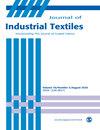Investigating the mechanical properties of 3D fused deposition modeling composites reinforced with continuous fibers: Effects of fiber number and negative Poisson structure
IF 2
4区 工程技术
Q1 MATERIALS SCIENCE, TEXTILES
引用次数: 0
Abstract
The use of 3D printers is expanding across various industries. The incorporation of reinforcing fibers and structures, such as negative Poisson, has the potential to enhance the mechanical properties of three-dimensional products. In this study, a specialized nozzle is developed for 3D Fused Deposition Modeling (FDM) printers dedicated to the production of continuous fiber-reinforced thermoplastic (CFRT) composites. The primary objective is to enhance the tensile strength and impact resistance of 3D-printed samples. It is achieved through the investigation of strategies such as fiber reinforcement, variation in the number of fibers within the reinforcing yarn, and the creation of samples featuring an internal structure with a negative Poisson’s ratio (NPRS). In this regard, four types of 3D samples are prepared including polymer only, polymer with a negative Poisson’s ratio structure, polymer reinforced with continuous fibers (glass and carbon fibers), and polymer reinforced with continuous fibers featuring a negative Poisson’s ratio structure. The mechanical properties of these samples, including tensile strength and impact resistance, are also compared. The results indicate that incorporating fibers as reinforcement can enhance the mechanical properties of 3D-printed products. Moreover, continuous fibers with more fibers within the same yarn count have an increased strengthening effect. The use of negative Poisson structures significantly improves impact resistance but adversely affects tensile strength.研究用连续纤维增强的三维熔融沉积模型复合材料的力学性能:纤维数量和负泊松结构的影响
三维打印机的应用正在各行各业不断扩大。增强纤维和结构(如负泊松)的加入有可能提高三维产品的机械性能。本研究为三维熔融沉积成型(FDM)打印机开发了一种专用喷嘴,专门用于生产连续纤维增强热塑性塑料(CFRT)复合材料。主要目的是提高三维打印样品的拉伸强度和抗冲击性。实现这一目标的方法是研究纤维增强、增强纱线中纤维数量的变化以及创建具有负泊松比(NPRS)内部结构的样品等策略。为此,我们制备了四种三维样品,包括纯聚合物、具有负泊松比结构的聚合物、用连续纤维(玻璃纤维和碳纤维)增强的聚合物,以及用具有负泊松比结构的连续纤维增强的聚合物。同时还比较了这些样品的机械性能,包括拉伸强度和抗冲击性。结果表明,加入纤维作为增强材料可以提高 3D 打印产品的机械性能。此外,在相同纱线支数下,纤维数量更多的连续纤维具有更强的增强效果。负泊松结构的使用可显著提高抗冲击性,但会对拉伸强度产生不利影响。
本文章由计算机程序翻译,如有差异,请以英文原文为准。
求助全文
约1分钟内获得全文
求助全文
来源期刊

Journal of Industrial Textiles
MATERIALS SCIENCE, TEXTILES-
CiteScore
5.30
自引率
18.80%
发文量
165
审稿时长
2.3 months
期刊介绍:
The Journal of Industrial Textiles is the only peer reviewed journal devoted exclusively to technology, processing, methodology, modelling and applications in technical textiles, nonwovens, coated and laminated fabrics, textile composites and nanofibers.
 求助内容:
求助内容: 应助结果提醒方式:
应助结果提醒方式:


